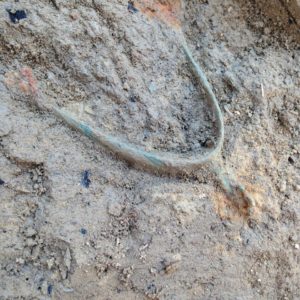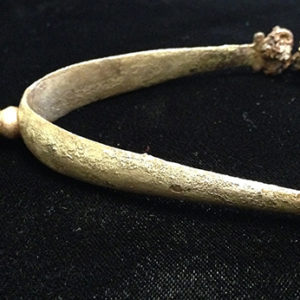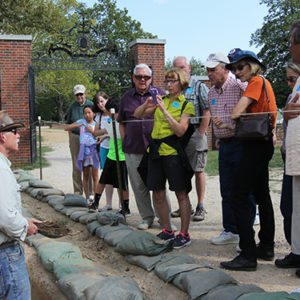The button from a doublet jacket of the type Captain John Smith wore in his portrait. A copper alloy finger ring with the remains of gilding on the inside. A small copper alloy hinge that could have fastened a book or a small box.
These artifacts came out of the large pit feature near the corner of the James Fort extension in the last weeks of September. But archaeologists for the Jamestown Rediscovery Project are wondering why more artifacts haven’t come out of the feature.
Jamestown Rediscovery Curator of Collections Merry Outlaw said the artifacts found in September range from the beautiful to the commonplace but do not appear to have a connecting theme yet.
“It seems like these are the kinds of artifacts we would find in a well that has become a trash pit, coming from lots of different places. But it’s not as jam-packed as we usually find the artifacts in wells,” she said.
The pit feature has been quartered so the archaeologists can clearly see the profile of the soil layers as they gradually work downward. They are still working in the first quarter, and the revealed soil and unearthed artifacts from that quarter have so far not shown strong evidence of what the feature may be. Dr. William M. Kelso, Director of archaeological research and interpretation at Historic Jamestowne, said the team may complete this first quarter in the remaining archaeological season for 2014.
One of the most significant artifacts found near the end of September was a brass spur. Now stabilized by Conservator Dan Gamble, the spur shows decorative elements and includes two buckles for the leather strap fastening the spur to a boot.
Archaeologists also found a fragment of the base of a Chinese tea bowl—from a time when English gentlemen were not drinking tea but carried such objects to show how well-traveled and wealthy they were.
“It displayed the status of the owner,” Outlaw said. “It set them apart from the ordinary individual. It was a very costly item.”
A German saltglazed stoneware Bartmann jug from the feature dates to the third quarter of the 17th century. Its poorly-executed medallion even appears to bear the date 1664. Instead of the bulbous form that is common on Bartmann jugs found in earlier fort contexts, this Bartmann is pear-shaped.
“The design elements on this jug are debased. The face is scowling and has wild eyebrows. Earlier faces are smiling and more realistic,” Outlaw said.
Other artifacts from the pit include a square copper alloy coin weight made in Antwerp, Belgium, that would verify the worth of the 16th-century gold Hungarian ducat, an iron buckle, and a shark vertebra. Senior Jamestown Rediscovery Archaeologist Danny Schmidt said these first artifacts from the pit feature are not yet associated with a specific layer of soil that can be tightly dated.
It’s possible that these artifacts and this summer’s other work in the open units by the Preservation Virginia welcome gate were tossed into a building—only the second fort period structure the Jamestown Rediscovery archaeologists have examined outside the James Fort’s original triangular palisade. The first was Structure 165, “The Factory” building outside the southeast bulwark of the fort that was investigated more than a decade ago.
In 2011 archaeologists followed the markings of a palisade wall jutting east off of the original James Fort’s eastern wall. Thought to be part of an extension that turned the original three-sided fort into one with five sides, a total of 69 feet of the wall was uncovered between excavations in 2003 and 2011. Now the archaeologists may have found the terminus of that wall: 15 feet to the east of where they last dug that eastern palisade in 2011. In that area sits a series of postholes and the pit feature.
This summer’s work also revealed a line of postholes just a few feet west of the pit feature now being excavated. In the last week of September, Kelso had the archaeologists open another unit to the north to see if they could find more postholes in that same line, which could confirm what the postline suggests: the settlers enclosed much more of the western edge of Jamestown Island than was previously known.
related images
- Brass spur still in the ground
- The brass spur after conservation
- Conservator Dan Gamble excavating a fragile iron artifact in the pit feature
- Dr. Kelso showing artifacts to visitors









